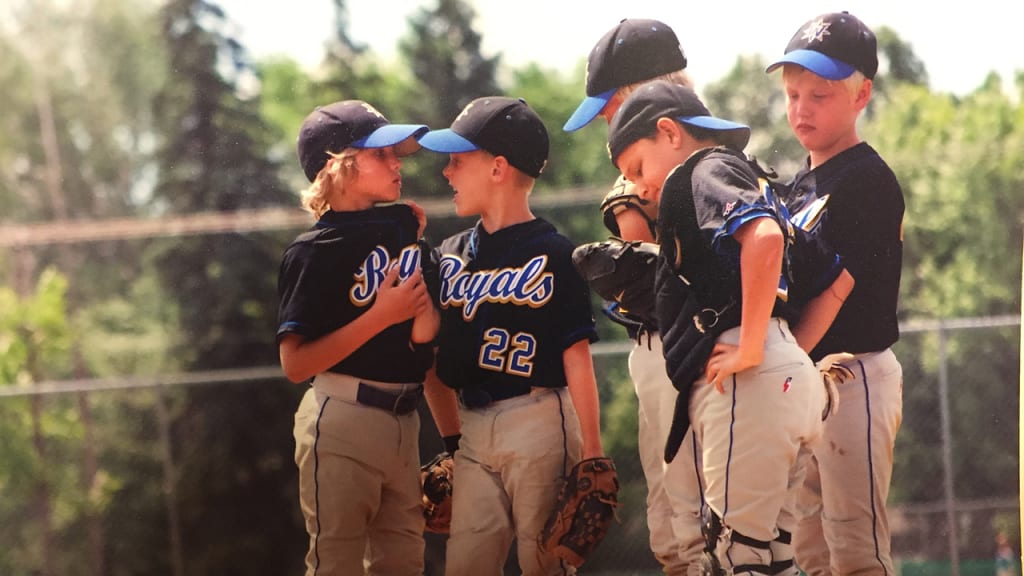Kent and Kathy Meyer still laugh about the picture.
Their son, Max, whom the Marlins selected third overall in the 2020 MLB Draft, was 9 years old, playing up one age group for the Woodbury Royals. He was the youngest kid on the team, although he didn’t act like it.
During a tournament in St. Cloud, Minn., Max’s friend Logan Welch entered to pitch in a precarious spot. Late innings. Narrow lead. Runners on. Logan finished his warmup tosses and was about to face his first batter when the Royals’ third baseman unexpectedly joined him on the mound.
Actually, joined is too tepid for what transpired: Max stared at his buddy, brim to brim, while grabbing a fistful of Logan’s jersey. A dozen years later, Logan can’t recall Max’s precise exhortation. But the audacity endures.
“I think he either said, ‘Don’t blow it!’ or, ‘Go get it for us!’” Welch recounted this week in a telephone interview. “And then half a second later, he was back to joking around and being silly.”

In a different era, the resulting tableau -- Max’s ferocity, Logan’s resolve, Minnesota’s soft summer twilight -- would grace the cover of The Saturday Evening Post.
Instead, it was a Rockwellian sign of things to come.
“I really can’t remember that moment at all,” Max Meyer said, laughing, when asked about the photo. “All I have to remember it is that picture.
“It’s so funny to look at how I was back then -- really competitive, just having fun, joking around. The love of the game always has been with me.”
Long before the University of Minnesota right-hander possessed the 100-mph fastball and explosive slider that made Meyer a top five selection in the MLB Draft, his competitiveness was evident. In some ways, the trait was inherited.
Kent and Kathy started dating as seniors at St. Olaf College in Northfield, Minn., where they captained the football and women’s soccer teams, respectively. Kent was known as the smallest middle linebacker in the Minnesota Intercollegiate Athletic Conference -- but also one of its hardest hitters. Kent and Kathy’s eldest son, Ben, was born in 1996. Max arrived three years later.
Max didn’t spend his childhood emulating the Twins, Wild, Timberwolves or Vikings. The standard by which he measured himself was the big kid shooting hoops in his own driveway.
“Growing up, the only person I ever tried to model my game after was Ben,” Max said. “I just wanted to be good enough to play with him, to hear him say, ‘Hey, good job, you’re looking better.’”
Kathy remembers Max wanting desperately to be as tall as Ben, but even smoldering Midwestern willpower has its limits. Ben stands 6-foot-4. Max is 6-foot-1.
When Ben left home to pitch at the University of St. Thomas in St. Paul, Max, then a high school sophomore, decided that he wanted to play college baseball, too. For many high school athletes, that ambition would have signaled an abrupt change: halt other sports and train year-round on the one that could yield a college scholarship.
But the Meyers view youth sports differently -- because Kent and Kathy were college athletes themselves; because Kathy, as a high school mathematics teacher, considers the context of a teenager’s overall development; and because Kathy’s brother, Joel Johnson, is a successful coach with USA Hockey and the storied women’s hockey program at the University of Minnesota.
And so Max continued playing forward on the Woodbury High School hockey team through his senior year.
“Our philosophy was always to keep having fun and play everything,” Kent said. “I’ve read stories about kids getting burned out on a sport because their parents were running them wild. I never told our kids, ‘You’re going to be an MLB player.’ You’re just providing them opportunities to play.
“Max always loved playing all the sports. Ben did, too. The other sports gave them a break and prevented the wear-and-tear on their arms.”

Welch noticed the benefit of that balance as a teammate at Woodbury High School -- notwithstanding Meyer’s fiery moment on the mound as a third grader.
“He was always the most calm, cool, collected player,” said Welch, who graduated recently with a finance degree from Minnesota State University in Mankato and will begin work as a financial analyst with Optum. “It doesn’t matter if he was having a great day or made an error. He always found a way to keep things loose -- making fun of guys, making fun of himself, making fun of the coaches. But he also knew when it was time to pay attention and get serious.”
Meyer’s combination of a fastball in the triple digits, a slider reaching 91 mph, and relatively light amateur workload is rare among elite Draft prospects. In high school, Max didn’t pick up a baseball during hockey season. Because he was a reliever and two-way player for periods of his college career, Meyer has thrown fewer than 60 innings per year, on average, from 2017 to present. That includes 13 innings with last summer’s USA Baseball Collegiate National Team, which he led with a 0.69 ERA.
There is a homemade quality to Meyer’s brilliance. When Max was in high school, Kent saw a video demonstration of the Core Velocity Belt that has become popular among pitchers in improving the strength and efficiency of hip rotation. Kent, who co-owns Meyer & Sons Construction, was intrigued.
“I said to myself, ‘I think I can make that out of my safety harness, bungees, and stuff that I have here at the house,’” Kent recalled.
In short order, the Meyers had a mound and throwing cage in their garage. Max always had been able to throw hard -- that’s why he played on the 10-year-old Royals as a 9-year-old -- but the handcrafted training equipment aided a dramatic velocity increase during high school.
When Max threw a pitch at 81 mph, Kent would ask if he could work his way up to 83 -- and give him a $10 bill if he did. Max is a self-described “old-school pitcher” who doesn’t love discussing mechanics, but he believes those repetitions in the garage conditioned him to “stay deeper” into his back leg and generate more power.
“It’s all about intent,” Kent said. “I’ve always said, ‘If you want to throw harder, you need to keep throwing harder.’ Max is blessed by God to have the arm and ability that he has, but he’s also had the intent and desire to get better.”
Meyer was an everyday position player for the Gophers as a sophomore, batting .256 over 121 at-bats and 32 starts. Max loved playing the infield. Gradually, more of his appearances came in the outfield or as a designated hitter, in order to reduce the likelihood of an injury.
“He was in the outfield for the fall game, but he doesn’t know how to go partway,” Kathy recalled. “He dove for a ball, caught it, jumped up and threw the ball home. The coaches were like, ‘Max, you can’t do that.’”
Asked if he brings a hockey mentality to the mound, Max laughed.
“Of course,” he said. “It’s just the passion I play with. I have a fire in my chest when I’m on the mound. I want to dominate the other team. I do think a lot of that comes with my hockey background.
“I did lead my team in penalty minutes my last year in high school.”
Max’s life away from baseball has remained consistent even as his professional prospects soar. Ben continues living in the Twin Cities after graduating from St. Thomas with a degree in mechanical engineering; he has worked in the sports data field for Sportradar. Max plays pond hockey each winter, making the short drive with his friends to Colby Lake when the ice and cloud cover are just right. Max often sees his grandparents, aunts, uncles, and cousins. Kathy’s parents live right next door.
Inevitably, some of Meyer’s routines will change as he enters pro baseball. Then again, perhaps the greatest disruptions have happened already. Max celebrated his 21st birthday on March 12, the same day a series in Colorado against Air Force was canceled due to the COVID-19 pandemic.
Of course, the Gophers never played another game in their 2020 season.
“His perspective from the start has been really good,” Kathy said. “He told us, ‘I did everything I could do this year.’ He started out great. He had a great spring. He was pitching well. As soon as the season stopped, he immediately focused on getting stronger.”
More specifically, Max set a goal of adding enough muscle to reach 200 pounds. By mid-May, he weighed 201.
The Meyers gathered as a family on Draft night to wait for Max’s name to be called. The uncertainty didn't last long. Even in a velocity-saturated era, 91-mph sliders have a way of standing out -- especially when thrown by an athlete who regards his craft with the proper blend of intensity and playfulness.
Just ask Logan Welch.


